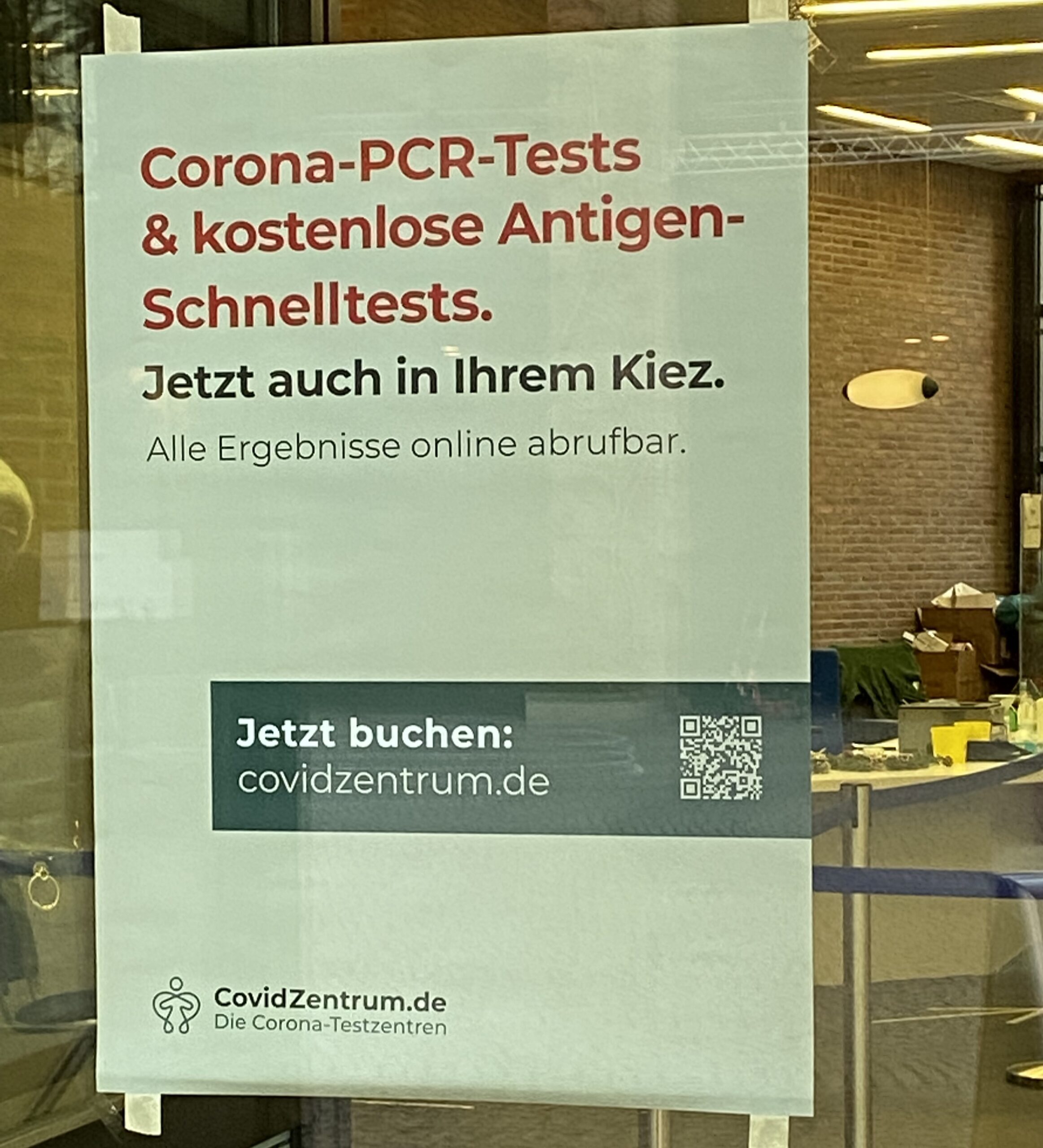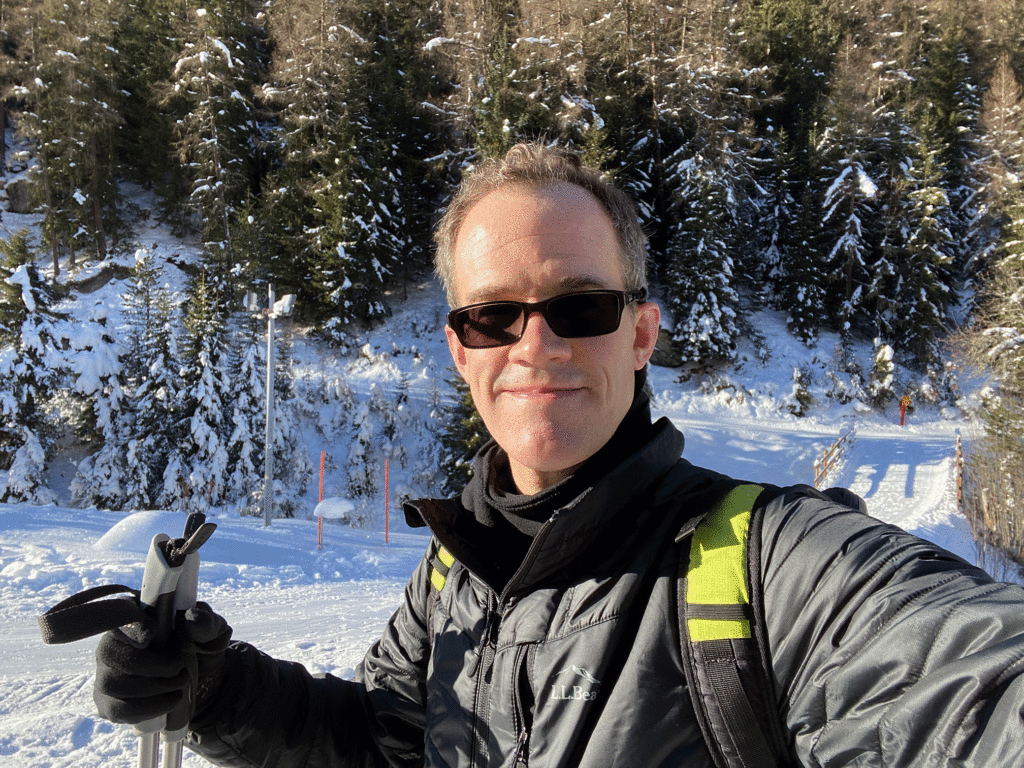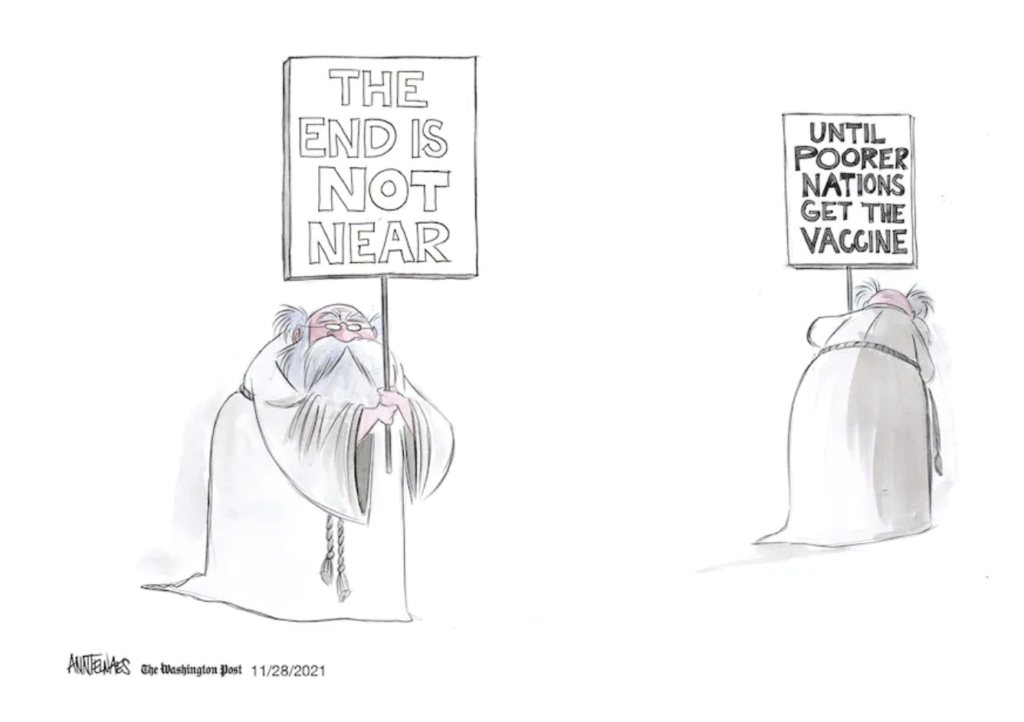In the Before Times, I often travelled internationally. But I have not left the United States in over two years.
Until last week. For the December holidays, my sister invited me to visit her, my brother-in-law, and niece in Switzerland – where they live. Since I no longer take international travel for granted, I decided to arrive a few days early, and take the train to Munich to visit a few friends.
Then Omicron hit. I considered cancelling or postponing. But I am vaccinated and recently boosted – all with an mRNA vaccine (Pfizer). I have been flying domestically since getting vaccinated; so, I am at least used to masked airline travel. And I miss my friends and family.
So, on Sunday, December 12, I left Manhattan, Kansas, bound for Zürich – only half-believing I would actually get there.
In case you are contemplating international travel, here are a few notes from my first trip to Europe in the Covid Era.
1. Embrace uncertainty. I prefer leaving the house with all my documents in order. But that wasn’t possible. To enter Switzerland, I needed a rapid PCR test that was less than 72 hours old. But rapid PCR tests are hard to come by where I live. Most places were offering a 3-5 day estimated result. But I found a CVS in Junction City (about 25 minutes’ drive from my house) that claimed a 1-2 day turnaround, even if it wouldn’t guarantee results within that time. So, I got a test there, and – as plan B – booked a PCR test with a guaranteed one-hour turnaround time at Boston’s Logan Airport. When I landed in Logan without results from CVS, I went straight to Gabisa Medical’s testing center in Terminal C. To their great credit, their lab gave me results in 37 minutes.
The cost? $250. And no, that is not a typo.

2. Be prepared to pay. Though my international flights were less expensive than usual, the cost of mandatory corona tests varies widely. In the US, covid testing is costly, scarce, and voluntary.
In Germany, covid testing is cheap (often free), plentiful, and mandatory. Switzerland is somewhere in between – more expensive and less mandatory than Germany, less expensive and more mandatory than the US.
A next-day PCR test in Munich (Germany) cost 69 Euros. A next-day PCR test in Sierre (Switzerland) cost 135 Swiss Francs. I needed the first of those to re-enter Switzerland. I got the second to re-enter the US. I needed only an antigen test, but the Sierre testing site was out of the antigen option.
A far smaller cost that was well worth it: I decided I wanted to get my analog US covid-vaccination card on the Swiss covid app. That cost 30 Francs. But getting it allowed me to get an EU QR code (free!), which in turn got me into the German covid app (also free!). Having the information on the apps was very convenient, and helped me better blend in with the general population. I recommend it.
3. Get used to getting a stick up your nose. Or, to borrow the English text for Germany’s very user-friendly corona test website, enjoy a “pleasant swab in the anterior nasal region.” These are required.
During my ten days abroad, I had two antigen tests and three PCR tests.
This is the system used in Germany, Switzerland, & possibly elsewhere.
- 2G is geimpft oder genesen [vaccinated or recovered]. You need 2G to dine in at a restaurant in Germany or Switzerland. When you enter, you show your ID (I took my passport with me everywhere) and proof of vaccination – an analog US card, CovPass (Germany’s covid app) or CovidCert (Swiss app).
- 3G is geimpft oder genesen, getestet [vaccinated or recovered, tested]. This requires an antigen test that’s less than 24 hours old. In Germany, these are very easy to sign up for, and they’re free. You need 3G for museums and theatre. When you enter a museum (for instance), you show your ID, proof of vaccination, and the QR code from your test. So that I could visit museums, I signed up to get a test each morning. I got results in 20 minutes, and stored them in my phone. I created a dedicated gmail folder for these and (just in case I didn’t have wi-fi) I made a place in the Apple’s “Notes” app where I saved each pdf with the QR code.
When I left Germany, these had changed slightly: boosted was counting as a 3G. I don’t know whether it still is.
4. The rules vary from place to place, and they keep changing. So, pay attention. (And see point 1.) When I arrived in Switzerland the first time, I was required to do a PCR test between four and seven days after arrival. When I arrived in Switzerland again just three days later, that was still required. But they dropped the requirement the next day.
My sister kindly found out where I could get an antigen test 24 hours before going back to the US – the US requires a less accurate but more recent covid test than Switzerland does. By this point, we were no longer near Zürich, but in the Alps of southwestern Switzerland. There, the location of the test kept changing. At first, we could get it at the town’s medical center. Then, no, the medical center would only treat locals, but the tourist office would do it. Then, no, the tourist office would not do it, and we ended up having to go to another town, further down the mountain. Laboratoire Salamin in Seirre gave me a test, but it only had the PCR.
5. Bring KN95 or N95 masks. (You can also buy additional ones when you’re there. In Europe, the KN95 is known as FFP2.) These are legally required in Germany. The Swiss accept flimsier masks (including cloth), but the Germans do not. In any case, the KN95 forms a better seal around your face (better protecting you and others). They also leave more space in front of your mouth, which I find more comfortable. I hadn’t really worn these until this trip. Now, I swear by them. I’m not going back to cloth masks.
As in the US, you are required to wear the mask on planes, trains, busses – on all public transport. You must wear them on an indoor train platform, but can take them off on an outdoor train platform. (Many travelers just leave them on outside, too.) You also must wear them in museums, theatres, hotels – any indoor public space.

Mask-wearing etiquette can be slightly arbitrary. At the hotel gym in Munich, I was obliged to wear the mask in between machines, but could take it off while using the machine. (Since there were few people in the hotel, I was often the sole person there.) At a restaurant, you wear the mask until you reach your table; then, you take it off. When you leave, you put it back on again. But, of course, to even get in to the gym or a restaurant, you have to be 2G – vaccinated or recovered.
6. Learn enough corona-related language or bring a translator (human or app). A possible consequence of there being far fewer English-speaking tourists: the information you need may not be available in English. In my experience, the people administering the test all spoke a bit of English. I speak a little German, and Germany’s testing website has an English option. But the signs at Munich’s Gasteig testing site were all auf Deutsch. Text messages received from the Zürich PCR test – and the paperwork to submit the results to the canton – were also solely in German. In Sierre, the website and signs were in French. (German is the dominant language in Zürich; French is the dominant language in Sierre.)

On my first day of getting the morning antigen test in Munich, I went early and to the wrong door. After a minute of standing around, I realized I was in the line for antibodies (to check if you’d had covid). I then walked over to the line for Corona-PCR-Tests & kostenlose Antigen-Schnelltests. In Sierre, the signs were all in French, which I do not speak. So, I stood in the wrong line until my sister returned from parking the car, and steered me to the right line.
If you lack a multilingual sister or friend, the GoogleTranslate app will render a clumsy version in English. It also has a camera option: when in the app, select camera, and point your phone’s camera at the text you need translated. The Deep-L app offers better translation, but lacks a camera.
7. Enjoy the peace of mind that responsible covid management provides. The frequent testing may sound like a hassle, but you get used to it. And it’s really comforting to know that there are systems in place to manage the pandemic, and that (most) people are following the rules.
I felt far safer in Europe than I do in the US. Absent any American covid-management structure, I – starting at the beginning of the pandemic – internalized a regimen of caution and vigilance. In Europe, the state supplies such a regimen. In the US, the approach to managing the pandemic continues to be very individualistic. In Europe, the approach is more systemic. Each approach affects my psychology in different ways. In Europe, I think “There are rules, systems to monitor compliance, and a broad agreement on following them” and I relax a bit. In the US, I think “It’s every man for himself!” and I’m always at least slightly on guard.
8. There are fewer travelers, which is both good and bad. My flights were not full. Nor were immigration lines. Nor were trains. Nor, for that matter, were lines to use the ski lifts. While those changes are welcome, others are less so. The international terminal (E) of Logan Airport had so few passengers that, in the area outside of security, all restaurants and shops were closed.
9. Live your life. Not everyone has the requisite capital, patience, or flexibility to travel abroad right now. But the coronavirus is not going away. So, within whatever options we do have, we all need figure out how to manage better – both personally and globally. I loved seeing family and friends, visiting museums, eating in restaurants, walking in the Alps, and taking cross-country ski lessons from an excellent instructor named Benoît Germann.

I also really enjoyed seeing other, better ways of managing a pandemic. If the US government were willing to be more proactive, we could better contain the spread and live more “normal” lives. The idea of free covid tests are not a joke, contrary to what Press Secretary Psaki suggested a few weeks ago. Germany and other countries are offering free covid tests. They’re an effective way of containing contagion and saving lives.
Also, if we’re ever going to fully prevail over covid-19 and its many mutations, we need to address global vaccine inequality. Build mRNA-producing plants on every continent. Give the patent to humankind. That’s a far more successful approach to fighting covid.

Related Posts
- Plague Songs
- Sing. Sing a Song. #PlagueSongs, no. 1 (17 Mar. 2020). Gloria Gaynor’s “I Will Survive.”
- Do Not Touch Your Face. #PlagueSongs, no. 2 (24 Mar. 2020). The Weeknd’s “I Can’t Feel My Face.”
- The Bright Side. #PlagueSongs, no. 3 (31 Mar. 2020). Monty Python’s “Always Look on the Bright Side of Life.” Also the first post where I began my practice of using a lyric as the title.
- It’s later than you think. #PlagueSongs, no. 4 (7 Apr. 2020). Prince Buster’s “Enjoy Yourself.” (Also, in recording this, I discovered that I cannot play ska. Musically, my rendition of this is easily the worst #PlagueSong.)
- There doesn’t seem to be anyone around. #PlagueSongs, no. 5 (14 Apr. 2020). Tommy James and the Shondells’ “I Think We’re Alone Now.”
- Be an optimist instead. #PlagueSongs, no. 6 (21 Apr. 2020). The Kinks’ “Better Things.”
- Kick at the darkness. #PlagueSongs, no. 7 (28 Apr. 2020). Bruce Cockburn’s “Lovers in a Dangerous Time.”
- So far away, but still so near. #PlagueSongs, no. 8 (5 May 2020). Robyn’s “Dancing on My Own.”
- If you just call me. #PlagueSongs, no. 9 (12 May 2020). Bill Withers’ “Lean on Me.”
- In the end, they’ll be the only ones there. #PlagueSongs, no. 10 (19 May 2020). Hanson’s “MMMBop,” and a few chords from Nirvana’s “Smells Like Teen Spirit.”
- No matter how I struggle and strive. #PlagueSongs, no. 11 (25 May 2020). Hank Williams’ “I’ll Never Get Out of This World Alive.”
- Love. #PlagueSongs, no. 12 (1 June 2020). Medley of Nick Lowe’s “(What’s so Funny ‘Bout) Peace Love, and Understanding” and the O’Jays’ “Love Train,” with brief snippets of the Staple Singers’ “This Train” and the Beatles’ “All You Need Is Love.”
- This is the time. #PlagueSongs, no. 13 (9 June 2020). Lou Reed’s “There Is No Time.”
- My neighbor and my friend. #PlagueSongs, no. 14 (16 June 2020). Fred Rogers’ “Won’t You Be My Neighbor.”
- If you’re lost, I’m right behind. #PlagueSongs, no. 15 (23 June 2020). Everything But the Girl’s “We Walk the Same Line.”
- Live to see another day. #PlagueSongs, no. 16 (30 June 2020). The Bee Gees’ “Stayin’ Alive.”
- Offer me solutions, offer me alternatives, and I decline. #PlagueSongs, no. 17 (7 July 2020). R.E.M.’s “It’s the End of the World as We Know It (and I Feel Fine).”
- Someday we’ll find it. #PlagueSongs, no. 18 (14 July 2020). Kermit the Frog’s “Rainbow Connection.”
- Can’t control my brain. #PlagueSongs, no. 19 (21 July 2020). Ramones’ “I Wanna Be Sedated.”
- 4’33” #PlagueSongs, no. 20. AND 43 notes on silence, time, and the corona era (28 July 2020). John Cage’s 4’33”, plus an essay inspired by the piece.
- Mann, wer hätte das gedacht, dass es einmal soweit kommt #PlagueSongs, no. 21 (4 Aug. 2020). Nena’s “99 Luftballons.”
- Banish sadness and strife. #PlagueSongs, no. 22 (11 Aug. 2020). “Look for the Silver Lining,” composed by Jerome Kern and Buddy DeSylva. My version is based on the Chet Baker recording. The final weekly #PlagueSong.
- Don’t write yourself off yet. #PlagueSongs, no. 23 (27 Oct. 2020). Jimmy Eat World’s “The Middle.” With this song, #PlagueSongs return at irregular intervals – roughly once a month.
- What’s that sound? #PlagueSongs, no. 24 (3 Nov. 2020). The Buffalo Springfield’s “For What It’s Worth.”
- Go tell that long-tongued liar. #PlagueSongs, no. 25 (17 Nov. 2020). A song known variously as “Run on for a Long Time” and “God’s Gonna Cut You Down.”
- I got the medicine. So, you should keep your eyes on the ball. #PlagueSongs, no. 26 (21 Dec. 2020). BTS’ “Dynamite.”
- I’m lucky to be here. #PlagueSongs, no. 27 (5 Jan. 2021). Warren Zevon’s “Don’t Let Us Get Sick.”
- Don’t run. #PlagueSongs, no. 28 (9 Feb. 2021). The Ventures’ “Walk – Don’t Run.”
- Don’t worry that it’s not good enough. #PlagueSongs, no. 29 (1 Mar. 2021). “Sing,” written by Joe Raposo for Sesame Street.
- Still worthwhile. #PlagueSongs, no. 30 (16 Mar. 2021). “Smile,” written by Charlie Chaplin, John Turner and Geoffrey Parsons. The best-known recording is by Nat King Cole.
- Give Love. #PlagueSongs, no. 31 (2 Apr. 2021). “Under Pressure” by David Bowie and Queen.
- That’s what storms were made for. #PlagueSongs, no. 32 (4 May 2021). “Pennies from Heaven,” written by Arthur Johnston and Johnny Burke. Made famous by Bing Crosby and Billie Holiday.
- Situation’s tolerable. #PlaugeSongs, no. 33 (3 June 2021). The Traveling Wilburys’ “Handle with Care.”
- Get back up again. #PlagueSongs, no. 34 (2 July 2021). Chumbawamba’s “Tubthumping.”
- Don’t weaken. #PlagueSongs, no. 35 (30 Aug. 2021). “It’s a Great Life (If You Don’t Weaken),” written by Leo Robin, Richard A. Whiting, and Newell Chase. Popularized by Maurice Chevalier.
- I guess this might well be it. #PlagueSongs, no. 36 (11 Oct. 2021). Marcus Mumford and Tom Hove’s theme to Ted Lasso.
- I remember when you were here. #PlagueSongs, no. 37 AND Seven Xmas Playlists (6 Dec. 2021). Darlene Love’s “Christmas (Baby Please Come Home)” and Spotify playlists for your holiday listening.
- What Is Your COVID-19 Routine? & related
- What Is Your COVID-19 Routine? (22 Mar. 2020)
- What Is Your COVID-19 Routine? Part 2 (5 Apr. 2020)
- What Is Your COVID-19 Routine? Part 3 (19 Apr. 2020)
- What Is Your COVID-19 Routine? Part 4 (16 May 2020)
- What Is Your COVID-19 Routine? Part 5 (29 June 2020)
- Plague Is Halfway Over (If You Want It) (18 Nov. 2020). Reflections on the first 250 days of the pandemic.
- A Shot in the Arm (10 Mar. 2021). In which I get the first shot of Pfizer’s covid vaccine.
- A 2nd Shot in the Arm (29 Mar. 2021). In which I get the second shot of Pfizer’s covid vaccine.
- “a nest of trying”: the pandemic at 500 days (26 July 2021).

Jules
Philip Nel
Martin de la Iglesia
Philip Nel